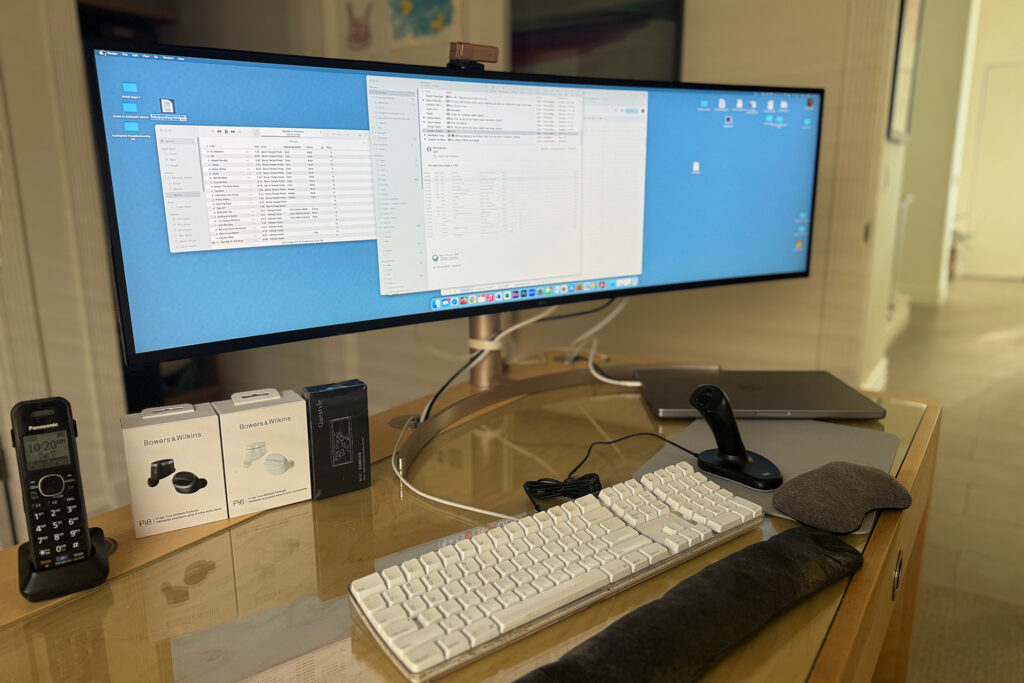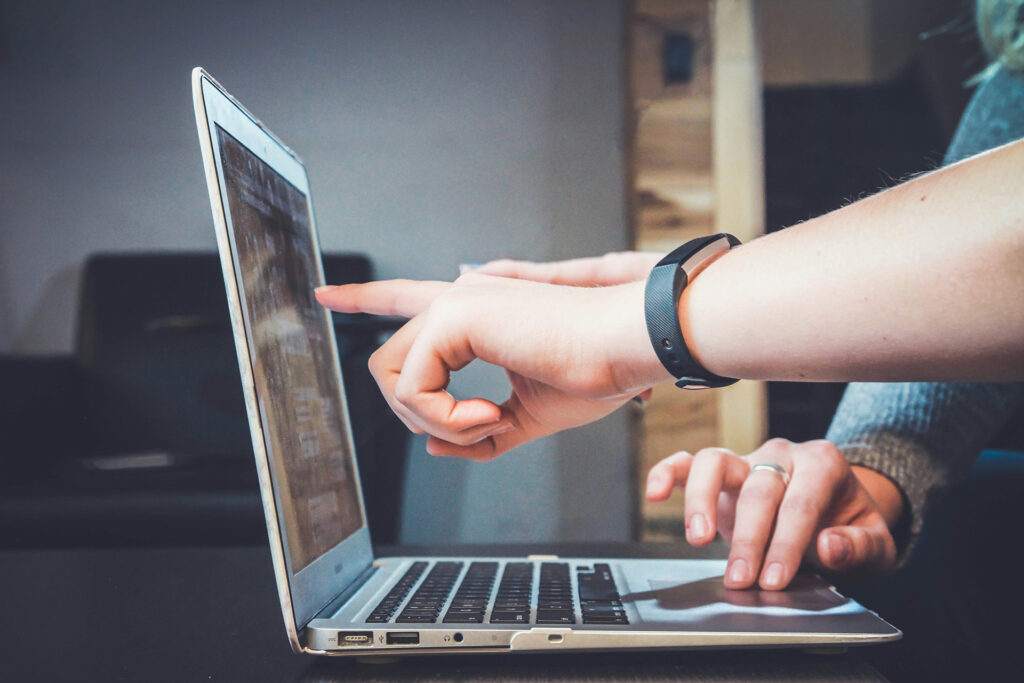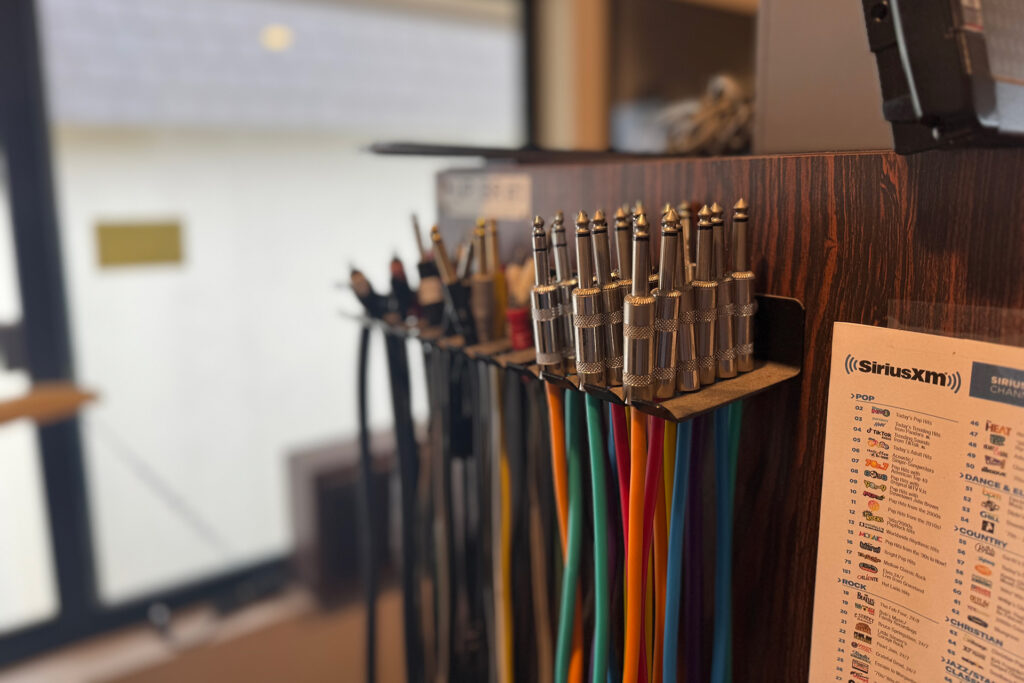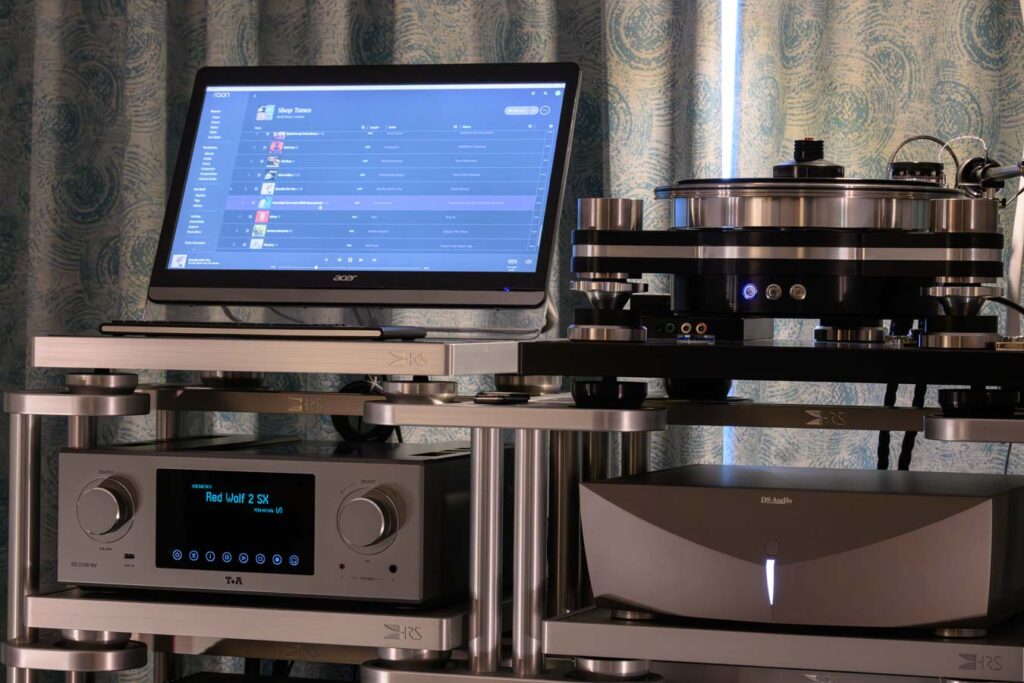One of my favorite professors in college was named Ken Lopez. He was the former president of JBL Professional and an overall great guy. This guy knew audio in ways that were tangential, but very important to my overall education in the field beyond the scope of just audiophile topics. Even more cool, Ken grew up in Monterey, California. and as a teen, he worked with the people that did the sound reinforcement for a late-spring, early-summer event called The Monterey Pop Festival. That happened to be the “coming out party” for a crazy, left-handed guitar player from Seattle who had been putting a band together in the United Kingdom earlier in 1967. The Monterey Pop Festival was his band’s first meaningful show in the United States, and it ended with a white Fender Stratocaster being set on fire to the amazement of everyone in attendance.
In class, Ken had so much to teach us impressionable Music Industry students at USC in the early-to-mid-1990s. When he left JBL, he worked for an early digital audio platform (like Pro Tools, but a different company), so he helped us see the power of how a record could be recorded, edited and mixed on a mere MacIntosh computer versus a $1,000,000-plus SSL mixing console and a hyper-complicated Studer two-inch tape machine. That was eye-opening. His extensive background in musical instrument (MI) retail was also eye-opening, especially for me, as I was immersed in ultra-high-end audio retail, selling products like Wilson Audio, Cello and others at the time as a lucrative and formative part-time job. But one day, Ken got mean-spirited. In a smaller, lab-based Music Industry class, he had the students set up a pretty edgy-at-the-time computer-based recording system. That’s not diabolical at all, but the twist that he added was. Ken purposefully didn’t provide us enough digital audio cables to make the system work. I took the lead for the students as we started swarming around the setup. It didn’t take me 15 minutes of the roughly 90-minute class to realize that we were missing an AES-EBU digital cable. I made that fact well known to Ken, who then enthusiastically told me that I was wrong and to keep going. Keep working on making it work. We put our thinking caps back on, but we eventually protested again, and Ken was unrelenting in his belief that “everything you needed to record was provided.” It wasn’t.
With only a few minutes left in class, Ken finally admitted that he was messing with us – on purpose. We wanted to kill him. I am serious, as we were that angry. We deduced what the problem was over an hour ago. What the hell lesson was he trying to teach us here? Man, we were so young and stupid that we didn’t see the point. Not at all. What Ken was teaching us wasn’t how to troubleshoot a digital audio workstation. Ken was teaching us how to deal with an asshole boss making ignorant and unrealistic requests in a professional environment. We didn’t see it at the time, but the lesson was pure gold, and one that would pay dividends in future lives, even if we couldn’t see it at the time.

How I Recently Ruined My Computer Workstation …
My home office is 10 by 11 feet, with some pretty high ceilings. For the past few weeks, I have been working on how to turn this little converted bedroom into a video studio for pending FutureAudiophile.com livestreams and YouTube.com videos (coming to you later in 2025 – stay tuned). Like pretty much everything that I do, I have taken this project to extreme levels of development (all audiophiles do this, it is just in our DNA). I have employed a CAA-represented video editor and screenwriter to help me with content production. Additionally, I have hired a veteran Hollywood veteran gaffer (aka: lighting designer for movie and TV sets) with 25 years of experience to curate the professional lights that will be mounted on the ceiling. Beyond that, an electrician is running HDMI cables for the camera to display on my Samsung Frame 4K TV on the far wall of my office. XLR cables will run to the installed boom mic that also will be mounted on the ceiling. My custom installation firm, Future Home, has been over to move my Crestron shade to allow for installation of bars needed to mount things to the ceiling. A custom, roll-down blackout shade is on order to allow me to remove any daytime ambient light that could interfere with my pending/new Hollywood lighting scheme. I even called my former editor (who I hired when he was too young to buy a beer – he’s in his 40s now), Andrew Robinson, who is now a total fixture on YouTube.com with audiophile and home theater topics. He had some really fantastic advice. Needless to say, we aim to produce video content that is anything but “some talking head blabbering into his iPhone.” Soon, I will be blabbering into a far more expensive rig with far higher production values at some point in 2025. Stay tuned.
Before all of the above machinations, I had a physically strong visitor help me move my quite heavy, custom-designed, glass-inlaid oak desk to a new position that was 90 degrees different from its traditional setting. This move brought all sorts of logistical issues with doors, AC outlets and other topics. However, it did get me to not sit in front of a window that simply washes me out. Anyone who has Zoomed with me in the past few years, sadly, could see this lame-ass presentation.
My main concern with this move was to NOT upset the apple cart with my computer workstation. I need my Apple MacBook Pro (M1 chipped and soon to be upgraded) and my beloved 49-inch LG 4K curved monitor (I finally realized why curved monitors make sense, because they suck in a home theater system, but are great on your desk) to remain functional, so I barely even disconnected anything. Realistically, I could have disconnected (and reconnected) the whole rig, as I was the one who set it up the first time, but I had been having some odd issues with my MacBook freezing up when I disconnected it from the two main USB-C cables. Those issues resolved themselves with a rare-but-needed restart of my laptop. I had called Apple and gotten some of their truly world-class support. They suggested that the USB hub that I was using was likely the issue, and that it should be replaced. I was able to live without that project completed, so why would that change when we moved my desk 90 degrees?
The silly answer is that Mercury is retrograde (even I don’t believe in that, but it was, in fact, retrograde as I checked before putting pen to paper for this here article), and things were destined to not go well at that time. Within five minutes of moving the desk, I couldn’t get my monitor to work. I said goodbye to my friend/helper and started in on trying to get myself back to work. I had no idea of the hell that I had just entered into.

Here Are Some of the Steps That I Took to Troubleshoot the Issue
- After things went haywire on that fateful Friday, I cut back to the basics and connected my laptop right to the monitor via USB-C. That’s a standardized way to connect a monitor in the Apple bubble, and it didn’t work. When I opened System Settings – Displays, there was no sign of the monitor. None.
- I tried an HDMI cable at my wife’s suggestion. I stole one that connected my secondary DirecTV receiver with my Crestron “brain” and, while this worked per se, the aspect ratio was off badly. However, the LG monitor was showing up as an option. A squished-looking option but, unlike USB-C, HDMI was at least showing up.
- I called Apple Support, because I was at that point in the process. Apple Care is pretty much the only warranty that I’ve found that is worth its money and, after an hour on the phone, I was elevated to a Senior Technician. I’ve made it to this level of extreme support before, but it is rare, as the more mainstream support people normally can easily solve whatever issues you have. The higher-up support agent was adamant about the importance of using good cables so, when I hung up with this lovely woman, I hustled over to Best Buy to buy a modern USB hub (long overdue), and I even bought some of Best Buy’s top-of-the-line $20 USB-C cables that supposedly are the cat’s meow.
- When I got home with my new parts, still nothing worked. Sadly, things were going to hell here, and fast. I called Apple back, and they quickly shot me to a higher-level support person. That technician and I went through every option that we could think of on the computer, the cables and settings in the LG monitor, but we couldn’t get the LG to see a USB-C input. This next agent was becoming confident that the physical USB-C input on the LG monitor was in need of repair. I called LG, they told me about how many weeks (yes, you read that right) it would take for that repair, and I felt a cold chill run down my spine. I simply can’t do what I do for a living on the 16-inch screen on my laptop, so I went back to Best Buy, and bought myself a second 49-inch 4K curved gaming monitor, and lugged this not-heavy but awkward box home.
- The newly purchased Samsung 49-inch 4K curved gaming monitor didn’t work, either.Nor did this new monitor have a much-needed USB-A input on the back panel, which is pretty much essential for my current setup, as USB-A is still used by many a computer device, such as my beloved vintage Apple keyboard and/or my joystick-like 3M mouse. As if one 49-inch curved monitor wasn’t immersive, two on the same desk was just batshit silly. Cables, power strips, and hubs (new, old and my wife’s) were strewn all over the place. This whole project was turning out to be a disaster. I spent a good hour filled with both brewing, seething anger and that sick-to-your-stomach feeling until I got desperate enough to call Apple back (again). This time they thankfully “called in the Wolf” to put things in Pulp Fiction parlance. This badass got on the phone and confidently brought up a topic that I had been reading about in the Apple Support forum. It seems that there had been a security update in the middle of the OS 14 lifespan (14.4.1, if you want to get really formal) that was designed to deal with hackers using the chips and other technologies built into today’s modern cables (I already miss a good XLR cable) that solves the security issue related to how people steal your credit card at the gas pump. Apple was on this matter, and quickly, too, which is admirable, but the detail that they didn’t share with me was that the cables could pass DATA but not VIDEO! How could this be? My main USB-C cable worked on Friday until about noon, but I was willing to go with the guru on the cable concept, as he was showing me the more up-market version of USB-C cables that Apple sells, which are $129 for three meters versus the $20 that Best Buy charges. He said, “We know with 100 percent certainty that the cables sold at the Apple Store are Thunderbolt 4 DisplayPort Pro-approved, which is what you need to pass video.” I had him look at the inventory at the Apple Store in Santa Monica, and there was one Apple-branded three-meter cable in stock. 15 minutes later, I am hustling through the waves of tourists on Third Street Promenade, trying to get that last cable in my hands. I was successful with my cable buy. I also was able to pick up two non-Apple-branded, slightly shorter but also approved USB-C cables that were far less expensive, as well as a much more serious USB hub that also came from the Apple Store.
- It didn’t take long to test the new goodies and THEY WORKED! I connected the Apple cable from my MacBook Pro to the LG monitor, and it immediately saw the LG monitor. Unlike with HDMI, the aspect ratio was correct, and things were working in ways that none of our earlier attempts did. The hub worked, too, so I started piecing my workstation back together. I was back in business again, and none too soon.
In my years in AV, I’ve been through some brutal troubleshooting. You’ve also now heard about my college torture testing, too. This experience might have been the toughest one to date. The whole concept that the USB-C cable previously passed video but stopped was so off-the-wall that it had all of us scratching our heads.
I did hop on a quick chat with Apple to say that we resolved the issue but, more importantly, to suggest to them that they might want to update their notes on this matter, and make the version of the cable a bigger part of their guidance. They were happy to hear from me, it seemed, but I was way behind. Before I got back to my backlog of work, I also email my IT consultant, who is a Certified Apple Consultant (that’s like a Master’s Degree in Apple), so she could share my lessons/pain with the other consultants in their chat. Nobody should have to suffer as I did, and I wanted to do my little part to make sure of that.

So, You Are Telling Me That Cables Don’t Matter in Audio?
I am not a total cable skeptic in the audiophile world, but I am not looking for cables that add anything sonically to my system, nor do I think you need to spend $30,000 on a pair of speaker cables to enjoy your music playback system. I’m looking for cables that are sized right and that are flexible enough for my installation in one of two big eight-foot-tall Middle Atlantic equipment racks. I don’t want any EQ or extra flavor added to my system. That’s my political stance on cables, which likely costs me plenty in lost advertising, but I will survive.
The idea that cables don’t work or somehow physically fail is a rare occurrence in our hobby, especially when dealing with professionally-made audiophile cables. Sure, it is possible that cables can get damaged, but unlike most of the connections in the computer or home theater world, such as USB, there are rarely any types of chips to get in the way of your connections, which is good. Many audiophile engineers who I know don’t like USB cables, because they not only pass video and data, but they also pass power. While you can absolutely connect a digital component (think: a DAC) via USB, the people with EE degrees suggest that it is a bit of a noisy connection for our pristine goals. Is such a connection good for your iPhone? It sure is, as you get the best of all worlds that way, but connections like COAX, or my preferred digital connection, AES-EBU (one with an XLR connector at both ends), are likely better.
There are many who say that cables have no effect on the sound of your audiophile system. They are wrong. Do you have to spend $35,000 on EQed speaker cables from the My Pillow Guy when he’s not in some frothing-at-the-mouth Trumpy rant on social media attacking people who caught COVID? Nope, you do not have to buy that kind of voodoo – nor should you. Buying well-crafted cables that get out of the way of your audio is a good idea. Using the best connections with the most stable connections is also a good idea, so that you never bring the type of acrimony that I had with my computer rig into your audiophile setup.

Some Helpful Tips for Troubleshooting Your Audiophile System
- Start by stripping things down to the basics. When things go wrong, try going back to the most basic connections, and build from there. As each complexity is examined, you have a chance to sniff out the culprit as to what is messing your audiophile world up a bit.
- Aggressively look for the weak link or problematic component. This is where the USB-C cable still passing data really threw me for a loop, in that it seemed so very unlikely that the issue was the cables, but that was the culprit. This is how one of the earlier Support Experts came up with the idea that the internal USB-C connector inside of my legacy LG 49-inch monitor might have been our issue. In the audiophile world, sometimes swapping a left and right cable helps. Looking for blown fuses in gear can solve an issue. Swapping out cables is another option.
- Buy/find/borrow other components to swap in and out of your system. My wife’s USB dongle that she uses with her work computer was useful in testing issues in my work setup. So was her old (Santa will fix that this year, shhh…) 2018 MacBook Air, which helped start to point us in the right direction. You can do the same with your audiophile system, too. Having some extra cables around is helpful for basic troubleshooting. There are CDs made by Stereophile and others (I think Chesky Records offered such a test disc) that can help test all sorts of setup issues that can quickly get you out of a bind.
- Don’t be afraid to ask for help. I’d like to think that I can troubleshoot a computer problem pretty well, as I have been using Apple products since before the MacIntosh, but I was fully stumped by this nightmare. Apple’s support is fantastic, and ultimately helped me solve the issue. Your local audiophile dealer or custom installer can help you as well if things get too frustrating. A fresh set of eyes from an audiophile friend can be seriously helpful, too.
- Try to take breaks from audiophile troubleshooting, and never get too angry. Being some level of pissed off is a realistic part of working through these types of situations, but it doesn’t help you get the resolution that you want one second faster. In fact, when you sense yourself asking questions or having an inner dialog that includes phrases like “how dare this be …” or “I demand this not to be …”, then perhaps it is time to take a break. I stopped a number of times during my recent troubleshooting nightmare, and just kept balls in the air for work using the little 16-inch screen on my MacBook. The breaks helped me think of new ways to attack the problem from a calmer and more creative place.
- Don’t forget to check your physical connections. On the Pass Labs XP-25 that I own, there are pretty sweet Furutech speaker wire connectors installed on the back by the factory. I use raw speaker cable to connect them, and if the cables aren’t perfectly wound around the binding posts, they won’t work. That has made me feel pretty silly on more than one occasion, but it is now a go-to place to look for issues when I am swapping in and out audiophile power amplifiers.
- Don’t ever get embarrassed, because these problems happen to everybody. Paul Wilson just had an issue in upgrading to new $100,000 Porzilli Audio Grand Note loudspeakers (review coming soon). He couldn’t get one to play, and he was getting to that angry place that I referenced before. He was smart enough to call it a night, and attack the problem with a fresh perspective the next day with his local audiophile club friend. When they started using a test tone to track things down, they realized that it was an issue with one of the brand new six-figure retail speakers. Much like my amp issue, Paul’s speaker cable had (barely) slipped out of the binding post in a way that you couldn’t really visually notice. The solution was an easy one, but no shame is needed here, as these are new speakers, and who knew that you needed a little extra muscle in the connections, or the uber-high-end Nordost cables could slip out? Paul and his buddy know now.

Final Thoughts on Audiophile Troubleshooting …
The good news is that audiophile systems are pretty simple system configurations, as compared to a modern home theater or something like my computer setup. Most of your audiophile connections are analog, and even the digital ones are often pretty simple, as there is little difference in connecting an RCA cable from a turntable or a COAX cable from, say, a modern streamer to a top-performing audiophile DAC. Additionally, our familiarity with our audiophile system’s performance helps us to know what sounds right. If things somehow get out of phase, most audiophiles can hear that right away.
The important thing to remember in troubleshooting your audiophile system is that this system is designed to be a source of joy. Troubleshooting can get frustrating – and fast. Don’t let things get you down when hunting down gremlins in your audiophile system. Take breaks. Be willing to seek help from friends and professionals alike, as most will be willing to help. I don’t know of an audiophile company that charges for support, and I can think of two dozen off of the top of my head where it isn’t very hard to get the namesake designer or his key staff to help you over the phone. We have a cottage industry here, and that small community is a major benefit when we need high-quality support. Moreover, the people that work for audiophile companies are almost always very savvy, quite experienced experts, tantamount to the Senior Support Agents at Apple.
Never forget that this hobby is supposed to be about fun. Keeping your system working and performing at its best is part of that. Sometimes, it takes a little effort to keep your system rocking at peak performance, but it is worth every bit of the effort.
Do you have a troubleshooting story that you’d like to share? How do you best deal with maintaining your audiophile system over the years? Share with use below in the moderated comments. We will be quick to approve your thoughts, as we love to hear from you!




The Audio by Van Alstine audio troubleshooting flow chart is still very valuable decades after it was published. The chart is available at https://avahifi.com/pages/troubleshooting-flowchart
Make sure your cables are plugged in! I had issues with my optical cable from my desktop dac/amp into my iMac and it took me ages to discover that it needed a tiny push to make the connection.